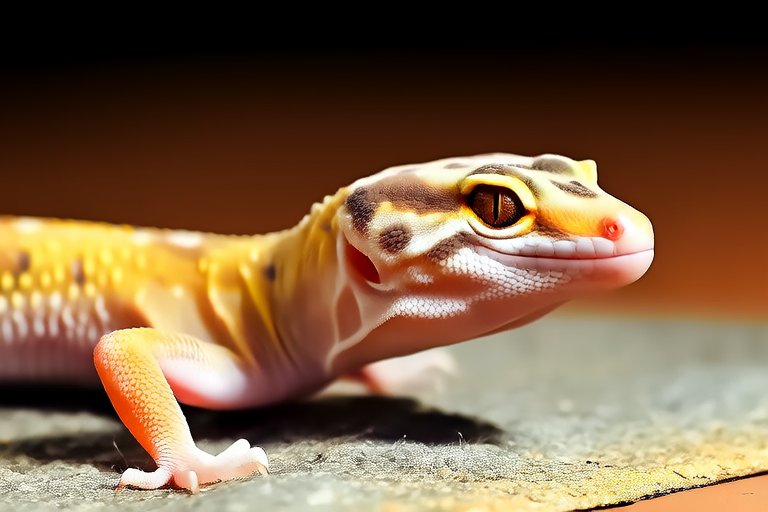From Beginner to Pro: Raising Healthy Leopard Geckos at Home
Welcome to the fascinating world of leopard geckos! These charming reptiles have gained immense popularity among pet owners due to their docile nature, ease of care, and vibrant colors. As one of the most popular reptile pets, leopard geckos offer an excellent entry point into the world of herpetology. This guide will walk you through the essentials of raising these delightful creatures, from setting up their environment to understanding their dietary needs and providing proper care.
Setting Up the Ideal Habitat
The first step in becoming a successful leopard gecko owner is creating a suitable habitat. Leopard geckos thrive in environments that mimic their natural desert habitats. A 20-gallon tank or larger is recommended for a single adult gecko, offering ample space for exploration and exercise. Use a secure lid to prevent escapes and ensure good ventilation.
Substrate choice is crucial. Avoid loose substrates like sand, which can cause impaction if ingested. Instead, opt for paper towels, reptile carpet, or tile. These materials are easy to clean and pose no risk to your gecko’s health.
Provide hiding spots and climbing areas to stimulate natural behaviors. Half logs, cork bark, and commercially available hide boxes work well. Ensure there’s enough variety to accommodate different times of day and mood changes.
Essential Equipment
In addition to the enclosure, several pieces of equipment are necessary for maintaining optimal conditions:
- Heat Lamp: A heat lamp is vital for regulating temperature gradients within the tank. Position it on one side to create a basking spot between 88°F and 95°F (31°C – 35°C).
- UVB Lighting: While not strictly necessary, UVB lighting can enhance calcium absorption and overall health.
- Humidity Box: A humid hideout helps maintain moisture levels, especially during shedding periods.
- Thermometer and Hygrometer: Monitor temperature and humidity regularly to ensure they remain within the desired range.
Temperature and Humidity Requirements
Maintaining appropriate temperatures and humidity levels is critical for your gecko’s health. Daytime temperatures should range from 78°F to 85°F (26°C – 29°C) at the cool end of the tank. At night, temperatures can drop slightly but should never fall below 70°F (21°C). The humidity level should be kept low, around 30% to 40%, to prevent respiratory issues.
Aim for a gradient so that your gecko can move between warmer and cooler areas as needed. This allows them to thermoregulate effectively.
Diet and Feeding Schedules
Leopard geckos are insectivores, meaning their diet consists primarily of insects. Crickets and mealworms are common choices, but variety is key. Offer a mix of dubia roaches, silkworms, and hornworms to ensure a balanced diet. Gut-load feeder insects with nutritious food before feeding them to your gecko to maximize nutritional value.
Feed juveniles daily, reducing frequency as they mature. Adults typically eat every other day. Dust insects with calcium and multivitamin supplements twice weekly to support bone growth and general health.
Handling and Socialization Tips
Leopard geckos are generally docile and enjoy gentle handling. Start by letting them acclimate to their new home for a week before attempting to handle them. Always support their entire body when holding them to avoid injury. Frequent, short sessions build trust and familiarity.
Some geckos may display shyness or stress responses, such as tail-dropping. Tail regeneration is possible, but prevention is better. Minimize handling during shedding periods and respect their need for privacy.
Common Health Issues and Signs of a Healthy Gecko
Regular observation helps catch potential problems early. Common issues include metabolic bone disease (MBD), caused by calcium deficiency, and respiratory infections. Signs of illness include lethargy, loss of appetite, labored breathing, and unusual feces.
A healthy leopard gecko exhibits clear eyes, active behavior, smooth skin, and regular bowel movements. They should also maintain a steady weight without appearing emaciated or obese.
Transitioning from Beginner to Advanced Care
As you gain experience, consider more advanced aspects of leopard gecko care, such as breeding. Breeding requires specialized knowledge about genetics, nutrition, and environmental control. Consult experienced breeders and join relevant forums for guidance.
Advanced care also includes recognizing subtle signs of stress or discomfort. Learning to interpret body language and behavioral cues deepens your understanding of your gecko’s needs.
Resources for Further Learning and Community Support
To continue expanding your knowledge, explore books, documentaries, and online courses focused on reptile care. Join local clubs or online communities where enthusiasts share experiences and advice. Websites dedicated to herpetology provide valuable insights and connect you with like-minded individuals.
Stay informed about the latest research and best practices by following reputable sources. Engaging with the broader reptile community fosters a supportive network and enriches your journey as a responsible pet owner.
